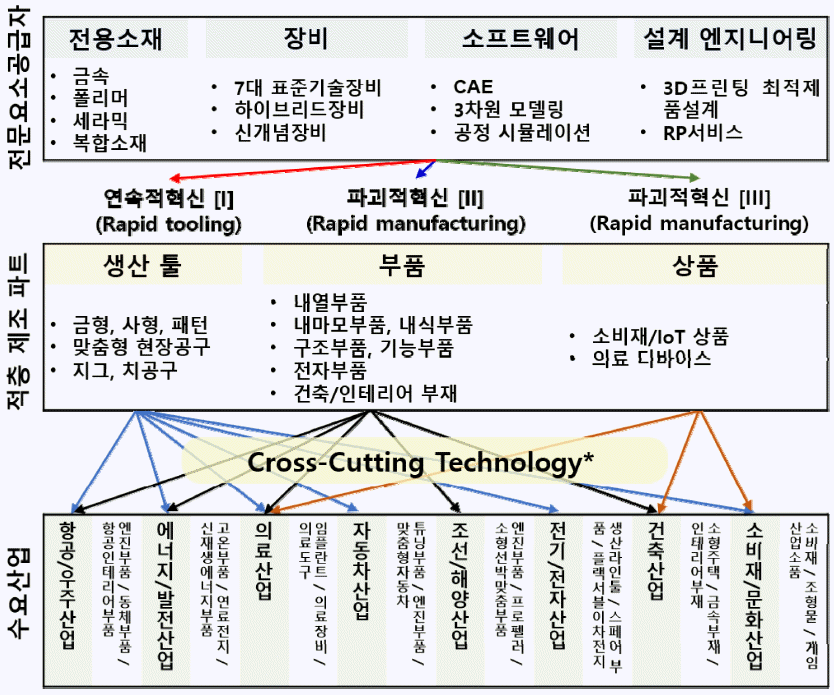Search
- Page Path
- HOME > Search
- [Korean]
- Technology Trend of Additive Manufacturing Standardization
- Hanshin Choi, Jinsu Park
- J Korean Powder Metall Inst. 2020;27(5):420-428. Published online October 1, 2020
- DOI: https://doi.org/10.4150/KPMI.2020.27.5.420

- 308 View
- 3 Download
-
 Abstract
Abstract
 PDF
PDF Additive manufacturing technology is recognized as an optimal technology for mass-customized distributed production because it can yield products with high design freedom by applying an automated production system. However, the introduction of novel technologies to the additive manufacturing industry is generally delayed, and technology uncertainty has been pointed out as one of the main causes. This paper presents the results of the research and analysis of current standardization trends that are related to additive manufacturing by examining the hierarchical structure of the quality system along with the various industry and evaluation standards. Consequently, it was confirmed that the currently unfolding standardization does not sufficiently reflect the characteristics of additive manufacturing technology, and rather can become a barrier to entry for market participants or an element that suppresses the lateral shearing ability of additive manufacturing technology.
- [English]
- Multi-step Metals Additive Manufacturing Technologies
- Ji-Won Oh, Jinsu Park, Hanshin Choi
- J Korean Powder Metall Inst. 2020;27(3):256-267. Published online June 1, 2020
- DOI: https://doi.org/10.4150/KPMI.2020.27.3.256

- 515 View
- 3 Download
- 3 Citations
-
 Abstract
Abstract
 PDF
PDF Metal additive manufacturing (AM) technologies are classified into two groups according to the consolidation mechanisms and densification degrees of the as-built parts. Densified parts are obtained via a single-step process such as powder bed fusion, directed energy deposition, and sheet lamination AM technologies. Conversely, green bodies are consolidated with the aid of binder phases in multi-step processes such as binder jetting and material extrusion AM. Green-body part shapes are sustained by binder phases, which are removed for the debinding process. Chemical and/or thermal debinding processes are usually devised to enhance debinding kinetics. The pathways to final densification of the green parts are sintering and/or molten metal infiltration. With respect to innovation types, the multistep metal AM process allows conventional powder metallurgy manufacturing to be innovated continuously. Eliminating cost/time-consuming molds, enlarged 3D design freedom, and wide material selectivity create opportunities for the industrial adoption of multi-step AM technologies. In addition, knowledge of powders and powder metallurgy fuel advances of multi-step AM technologies. In the present study, multi-step AM technologies are briefly introduced from the viewpoint of the entire manufacturing lifecycle.
-
Citations
Citations to this article as recorded by- Potential and challenges for Powder Bed Fusion – Laser Beam (PBF-LB) in industrial ceramic additive manufacturing
Christian Berger, Gabriela Schimo-Aichhorn, Stefan Gronau, Franziska Saft, Sarah Seiringer, Uwe Scheithauer
Open Ceramics.2024; 18: 100614. CrossRef - Fabrication of Cu-Infiltrated Journal Bearing by Binder Jetting Additive Manufacturing
Jin Man Jang
Crystals.2024; 14(11): 912. CrossRef - SiC-Si composite part fabrication via SiC powder binder jetting additive manufacturing and molten-Si infiltration
Ji-Won Oh, Jinsu Park, Sahn Nahm, Hanshin Choi
International Journal of Refractory Metals and Hard Materials.2021; 101: 105686. CrossRef
- Potential and challenges for Powder Bed Fusion – Laser Beam (PBF-LB) in industrial ceramic additive manufacturing
- [Korean]
- Technology Trend of Construction Additive Manufacturing
- Jinsu Park, Kyungteak Kim, Hanshin Choi
- J Korean Powder Metall Inst. 2019;26(6):528-538. Published online December 1, 2019
- DOI: https://doi.org/10.4150/KPMI.2019.26.6.528

- 523 View
- 3 Download
- 2 Citations
-
 Abstract
Abstract
 PDF
PDF The transition from “More-of-Less” markets (economies of scale) to “Less-of-More” markets (economies of scope) is supported by advances of disruptive manufacturing and reconfigurable-supply-chain management technologies. With the prevalence of cyber-physical manufacturing systems, additive manufacturing technology is of great impact on industry, the economy, and society. Traditionally, backbone structures are built via bottom-up manufacturing with either pre-fabricated building blocks such as bricks or with layer-by-layer concrete casting such as climbing form-work casting. In both cases, the design selection is limited by form-work design and cost. Accordingly, the tool-less building of architecture with high design freedom is attractive. In the present study, we review the technological trends of additive manufacturing for construction-scale additive manufacturing in particular. The rapid tooling of patterns or molds and rapid manufacturing of construction parts or whole structures is extensively explored through uncertainties from technology. The future regulation still has drawbacks in the adoption of additive manufacturing in construction industries.
-
Citations
Citations to this article as recorded by-
SiO
2
nanoparticle-coated Ti-6Al-4V spherical powder for powder bed fusion additive manufacturing process
Jongik Lee, Taehoo Kang, Ukju Gim, Sehun Kim, Sanghee Jung, Jimin Han, Bin Lee
Powder Metallurgy.2025;[Epub] CrossRef - Technology Trend of Additive Manufacturing Standardization
Hanshin Choi, Jinsu Park
Journal of Korean Powder Metallurgy Institute.2020; 27(5): 420. CrossRef
-
SiO
2
nanoparticle-coated Ti-6Al-4V spherical powder for powder bed fusion additive manufacturing process
TOP
 kpmi
kpmi


 First
First Prev
Prev


